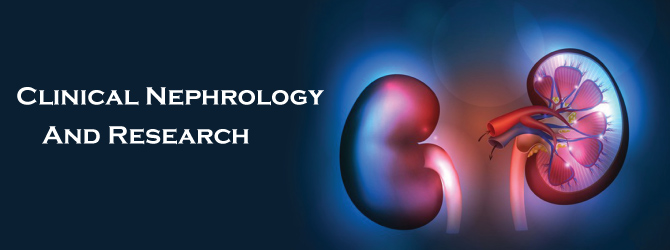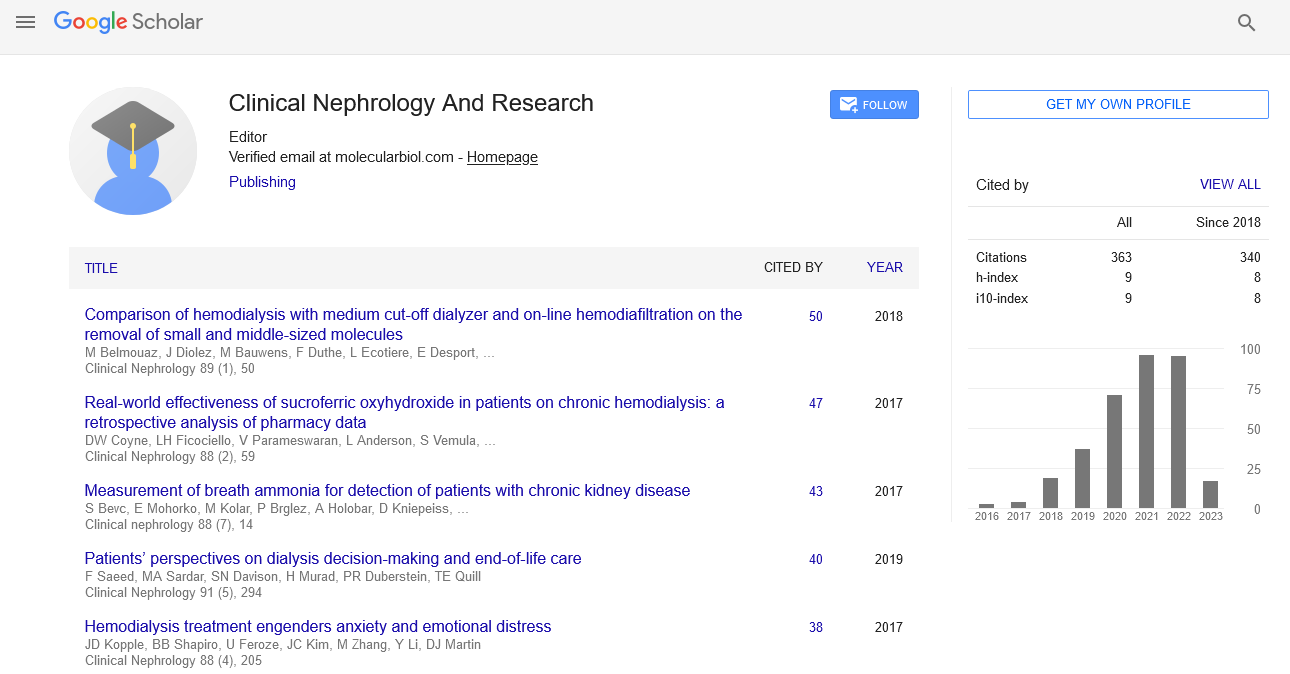Short note on chronic renal disease
Received: 05-Jul-2024, Manuscript No. PULCNR-23-6408; Editor assigned: 08-Jul-2024, Pre QC No. PULCNR-23-6408 (PQ); Accepted Date: Jul 15, 2024; Reviewed: 12-Jul-2024 QC No. PULCNR-23-6408; Revised: 15-Jul-2024, Manuscript No. PULCNR-23-6408 (R); Published: 30-Jul-2024
Citation: Mahi AO. Short note on chronic renal disease. Clin Nephrol Res 2023;7(1):1-2.
This open-access article is distributed under the terms of the Creative Commons Attribution Non-Commercial License (CC BY-NC) (http://creativecommons.org/licenses/by-nc/4.0/), which permits reuse, distribution and reproduction of the article, provided that the original work is properly cited and the reuse is restricted to noncommercial purposes. For commercial reuse, contact reprints@pulsus.com
Abstract
In individuals with cardio renal disorders, venous blockage has become a key contributor to renal brokenness. However, due to a significant crossover with prior renal disability caused by long-term hypertension, diabetes, and renovascular infection, only limited progress has been made in separating this hemodynamic aggregate of renal brokenness. We suggest Congestive Nephropathy (CN) as this medical condition that has been disregarded. A potentially reversible variant of renal brokenness known as CN is characterized by constantly increasing renal interstitial tension and reducing renal venous surge. Venous obstruction may result in a never-ending cycle of hormonal activity, increased stomach pressure, excessive renal cylindrical salt reabsorption, and volume overload, which in turn causes more Right Ventricular (RV) stress. Renal substitution therapy may eventually be anticipated to relieve diuretic-safe obstruction. Strong decongestion may help or save renal capacity. Complete renal capacity reclamation might be a corroborating demonstrative model for congestive intense kidney injury, which may not be related to cell damage. It's interesting to note that over time, renal brokenness and Histopathological damage might be brought on by persistently low renal perfusion tension. Urinary indicators may therefore contrast. While CN is typically associated with biventricular cardiovascular failure, it can also occur in addition to aspiratory blood vessel hypertension and elevated intra-abdominal pressure. A significant reduction in glomerular filtration rate is associated with an increase in focal venous pressure to >6 mmHg. The range of focal venous strain, however, that can provide the best balance between RV and renal capacity still has to be determined. We indicate areas for further research and provide models to identify cardio renal condition subgroups likely to benefit from decongestive or pneumonic hypertension-explicit therapies.
Keywords
Heart failure; Right ventricular; Intra-abdominal pressure; Central venous pressure; Cardio renal syndrome
Introduction
Reduced renal perfusion and the ensuing neurological and hormonal changes have long been regarded to be the primary causes of renal dysfunction in Heart Failure (HF). Recent research has shown persistent venous congestion as the main contributing cause. Inflammation, oxidative stress, excessive renal tubular sodium reabsorption, volume overload, ascites, hepatic dysfunction, intestinal mucosal ischaemia (with bacterial toxin translocation, high Intra-Abdominal Pressure (IAP), high Central Venous Pressure (CVP), and ascites all contribute to further RV stress. In the end, renal replacement therapy can be required to relieve congestion. This series of events seems to be crucial in the etiology of RV failure in individuals with pulmonary arterial hypertension 6 and, more frequently, biventricular HF.
This hemodynamic phenotype of renal impairment remains unclear despite evidence that untreated congestion in HF causes poor renal and general outcomes, whereas effective decongestion maintains or even improves renal function and enhances survival. This is largely attributable to the fact that people with both HF and CKD usually have Cardio Renal Syndrome (CRS), a complicated and divisive clinical entity including a variety of disorders brought on by multiple hemodynamic and non-hemodynamic factors.
Without a confirmed kidney biopsy, albuminuria and renal damage are commonly misinterpreted as hypertensive nephropathy or diabetic nephropathy since many CRS patients also have hypertension and/or diabetes. When combined with other pathophysiological pathways, the congestion brought on by HF and PH may aggravate renal impairment in people with CRS. It may be possible to adapt therapy by early identification of patient subgroups with cardiac and renal dysfunction and by phenotyping of underlying kidney disease processes.
Description
In animal models, blockage-initiated renal failure completely resolves when venous pressure is restored to baseline values, with the degree of success depending on the length and severity of the obstruction. An increase in renal function has been explained in a patient with HF who had peritoneal dialysis for decongestion. A recent post hoc analysis revealed that sildenafil therapy improved renal function and reduced PH related discomfort in individuals with aspiratory blood vessel hypertension. It is unclear whether the improvement in renal function is due to sildenafil's effects on the right ventricle and pneumonic vasculature (and the resulting decrease in venous clog), or if it may be inferred from its immediate vasodilator and remodelling effects on the renal vasculature, or both. Due to permanent tubulointerstitial damage, decongestion may not be effective in individuals with previous CKD, well-established renal hypo perfusion, or venous obstruction. The majority of studies on patients with end-stage HF who had a Ventricular Assist Device (VAD) implanted focused on renal function (43%–49% of whom had ischemic cardiomyopathy).
However, those with more severe preimplant renal brokenness and diabetes had a lower chance of progressing. The improvement in renal function was probably explained by less venous obstruction, increased fundamental perfusion, and decreased hormonal enactment. Renal Doppler ultrasonography in VAD patients with impaired renal function revealed increased mean end-diastolic speed and decreased mean peak systolic speed, which collectively reduced the renal opposition file. The most likely explanation is that a reduction in venous blockage triggered increased renal interstitial tension, which in turn caused an increase in the cross-sectional area of interstitial capillaries and improved diastolic flow. Renal function occasionally failed, which is probably related to fundamental CKD (as an alternative to long-term hypertension, diabetes, or neovascular disease), ongoing volume overload, or ongoing poor cardiac yield despite VAD implantation.
Conclusion
Guess varies often in individuals with concomitant cardiac and renal disease, so it's important to identify high-risk patients who can benefit from focused observation and therapy. Although the detrimental impact of clog on renal function has long been recognized, clinical practice has not yet given it the consideration it deserves. Early decongestion can influence renal function and outcomes. The precise definition of this hemodynamic accumulation of renal brokenness will help doctors identify patients who will benefit from certain administration techniques.
For a potentially reversible subtype of renal brokenness associated with falling renal venous surge and constantly increasing renal interstitial strain, we suggest the designation CN. On intrarenal Doppler ultrasonography, intermittent venous stream patterns may show CN and the need for detailed heart evaluation. More research is anticipated to confirm the role of intrarenal Doppler ultrasonography in the treatment of HF and PH, address the test for determining and advancing volume status, and identify the CVP value that provides the best balance between RV and renal capacity.





